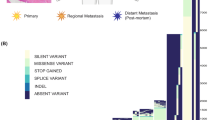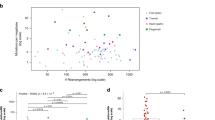Abstract
Analysis of DNA copy number changes using comparative genomic hybridization in melanocytic neoplasms has revealed distinct patterns of chromosomal aberrations between benign melanocytic nevi and melanoma. Whereas the vast majority of melanoma expresses chromosomal aberrations, blue nevi, congenital nevi, and most Spitz nevi typically show no aberrations. A subset of Spitz nevi shows an isolated gain of chromosome 11p, an aberration pattern not observed in melanoma. These Spitz nevi frequently harbor mutations in the HRAS gene located on this chromosomal arm. Comparisons among melanoma types showed that melanomas of the palms, soles, and subungual sites can be distinguished by the presence of multiple gene amplifications that arise very early in their progression. About 50% of these amplifications are found at the cyclin D1 locus. By contrast, amplifications are significantly less frequent in other cutaneous melanoma types and if present arise late in progression. The frequent amplifications in melanomas on acral sites allowed the detection of single basal melanocytes with gene amplifications in the histologically normal appearing skin immediately adjacent to a melanoma. These “field cells” represent subtle melanoma in situ and are likely to represent minimal residual disease that can lead to local recurrences if not excised with safety margins. The high frequency of chromosomal aberrations in melanomas and their relative absence in nevi could indicate that melanocytes of melanomas went through telomeric crisis, whereas melanocytes in nevi did not. Such a scenario would suggest that replicative senescence is a tumor-suppressive mechanism in melanocytic neoplasia. It might also explain part of the phenomenon of regression commonly seen in melanoma.
Genomic analysis is a powerful tool to obtain insight in the progression of melanocytic neoplasms with potential clinical applications for classification and detection of minimal residual melanoma.
This is a preview of subscription content, access via your institution
Access options
Subscribe to this journal
Receive 50 print issues and online access
$259.00 per year
only $5.18 per issue
Buy this article
- Purchase on Springer Link
- Instant access to full article PDF
Prices may be subject to local taxes which are calculated during checkout

Similar content being viewed by others
References
Amon A . (1999). Curr. Opin. Genet. Dev., 9, 69–75.
Barbacid M . (1987). Annu. Rev. Biochem., 56, 779–827.
Barnhill RL, Argenyi ZB, From L, Glass LF, Maize JC, Mihm Jr MC, Rabkin MS, Ronan SG, White WL and Piepkorn M . (1999). Hum. Pathol., 30, 513–520.
Bastian BC, Kashani-Sabet M, Hamm H, Godfrey T, Moore II DH, Bröcker EB, LeBoit PE and Pinkel D . (2000a). Cancer Res., 60, 1968–1973.
Bastian BC, LeBoit PE, Hamm H, Bröcker EB and Pinkel D . (1998). Cancer Res., 58, 2170–2175.
Bastian BC, LeBoit PE and Pinkel D . (2000b). Am. J. Pathol., 157, 967–972.
Bastian BC, Wesselmann U, Pinkel D and LeBoit PE . (1999). J. Invest. Dermatol., 113, 1065–1069.
Bastian BC, Xiong J, Frieden IJ, Williams ML, Chou P, Busam K, Pinkel D and LeBoit PE . (in press). Am. J. Pathol.
Blackburn EH . (2001). Cell, 106, 661–673.
Brash DE . (1997). Trends Genet., 13, 410–414.
Brash DE and Ponten J . (1998). Cancer Surv., 32, 69–113.
Brodeur GM and Hogarty MD . (1998). The Genetic Basis of Human Cancer. Vogelstein B and Kinzler KW (eds). McGraw-Hill: New York.
Clark WH, Elder DE and Guerry D . (1990). Pathology of the Skin. Farmer ER and Hood AF (eds). McGraw-Hill: New York, pp. 729–735.
DeDavid M, Orlow SJ, Provost N, Marghoob AA, Rao BK, Huang CL, Wasti Q, Kopf AW and Bart RS . (1997). J. Am. Acad. Dermatol., 36, 409–416.
Farmer ER, Gonin R and Hanna MP . (1996). Hum. Pathol., 27, 528–531.
Glover MT, Deeks JJ, Raftery MJ, Cunningham J and Leigh IM . (1997). Lancet, 349, 398.
Hanahan D and Weinberg RA . (2000). Cell, 100, 57–70.
Herlyn M and Satyamoorthy K . (1996). Am. J. Pathol., 149, 739–744.
Jen J, Powell SM, Papadopoulos N, Smith KJ, Hamilton SR, Vogelstein B and Kinzler KW . (1994). Cancer Res., 54, 5523–5526.
Jiveskog S, Ragnarsson-Olding B, Platz A and Ringborg U . (1998). J. Invest. Dermatol., 111, 757–761.
Kageshita T, Hirai S, Ono T, Hicklin DJ and Ferrone S . (1999). Am. J. Pathol., 154, 745–754.
Lindelof B, Sigurgeirsson B, Gabel H and Stern RS . (2000). Br. J. Dermatol., 143, 513–519.
Mathon NF and Lloyd AC . (2001). Nat. Rev. Cancer, 1, 203–213.
Pathak S, Multani AS, McConkey DJ, Imam AS and Amoss Jr MS . (2000). Int. J. Oncol., 17, 1219–1224.
Ramirez RD, D'Atri S, Pagani E, Faraggiana T, Lacal PM, Taylor RS and Shay JW . (1999). Neoplasia, 1, 42–49.
Rosenberg SA . (2001). Nature, 411, 380–384.
Sauter ER, Yeo UC, von Stemm A, Weizhu Z, Litwin S, Tichansky S, Nesbit M, Pinkel D, Herlyn M and Bastian BC . (in press). Cancer Res., 1, 20–22.
Scott RS, McMahon EJ, Pop SM, Reap EA, Caricchio R, Cohen PL, Earp HS and Matsushima GK . (2001). Nature, 411, 207–211.
Sherr CJ and DePinho RA . (2000). Cell, 102, 407–410.
Soengas MS, Capodieci P, Polsky D, Mora J, Esteller M, Opitz-Araya X, McCombie R, Herman JG, Gerald WL, Lazebnik YA, Cordon-Cardo C and Lowe SW . (2001). Nature, 409, 207–211.
thor Straten P, Becker JC, Seremet T, Brocker EB and Zeuthen J . (1996). J. Clin. Invest., 98, 279–284.
van Elsas A, Zerp SF, van der Flier S, KrŸse KM, Aarnoudse C, Hayward NK, Ruiter DJ and Schrier PI . (1996). Am. J. Pathol., 149, 883–893.
Veenhuizen KC, De Wit PE, Mooi WJ, Scheffer E, Verbeek AL and Ruiter DJ . (1997). J. Pathol., 182, 266–272.
Weinberg RA . (1989). Cancer Res., 49, 3713–3721.
Zhai S, Yaar M, Doyle SM and Gilchrest BA . (1996). Exp. Cell Res., 224, 335–343.
Ziegler A, Jonason AS, Leffell DJ, Simon JA, Sharma HW, Kimmelman J, Remington L, Jacks T and Brash DE . (1994). Nature, 372, 773–776.
Author information
Authors and Affiliations
Corresponding author
Rights and permissions
About this article
Cite this article
Bastian, B. Understanding the progression of melanocytic neoplasia using genomic analysis: from fields to cancer. Oncogene 22, 3081–3086 (2003). https://doi.org/10.1038/sj.onc.1206463
Published:
Issue Date:
DOI: https://doi.org/10.1038/sj.onc.1206463
Keywords
This article is cited by
-
Acral Melanoma: A Patient’s Experience and Physician’s Commentary
Dermatology and Therapy (2018)
-
Melanocytic nevi and melanoma: unraveling a complex relationship
Oncogene (2017)
-
Targeted next-generation sequencing reveals high frequency of mutations in epigenetic regulators across treatment-naïve patient melanomas
Clinical Epigenetics (2015)
-
NRAS Mutation Is the Sole Recurrent Somatic Mutation in Large Congenital Melanocytic Nevi
Journal of Investigative Dermatology (2014)
-
Comparative genomic hybridization for the diagnosis of melanoma
European Journal of Plastic Surgery (2010)



